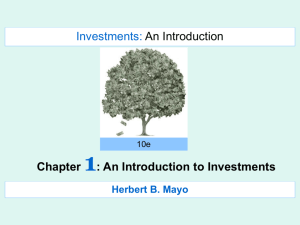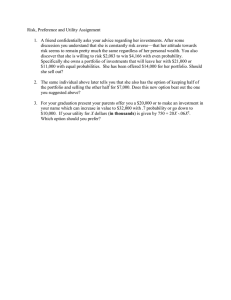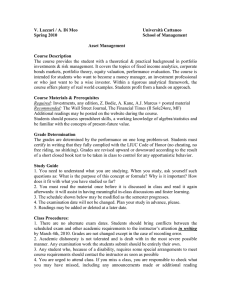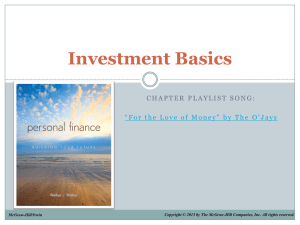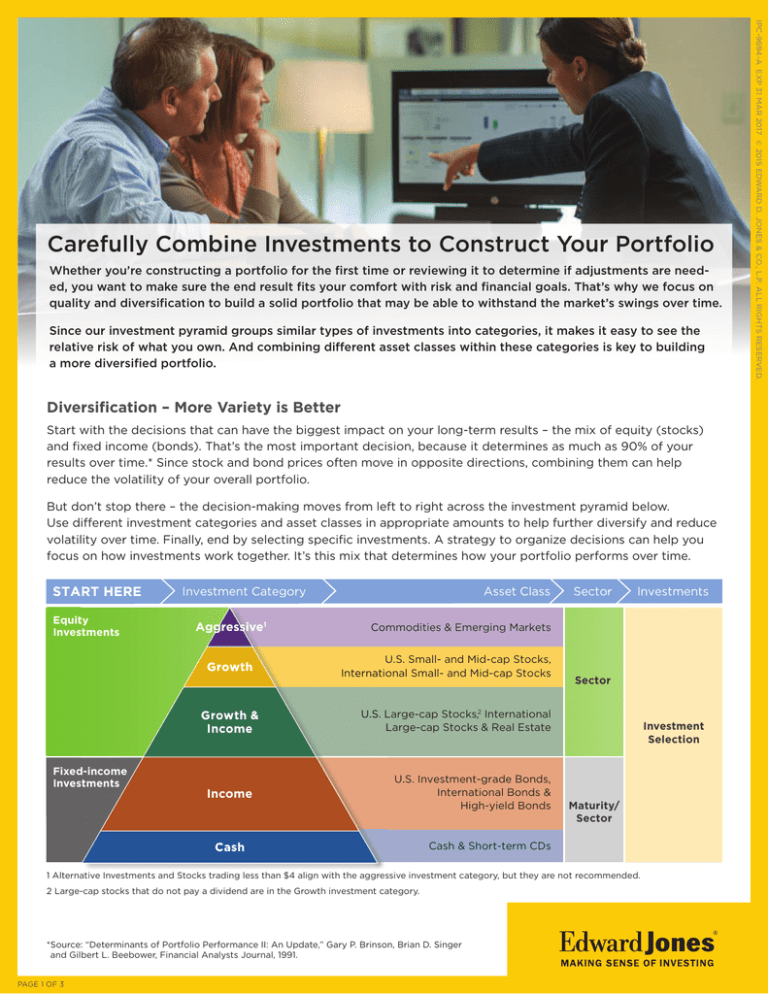
Whether you’re constructing a portfolio for the first time or reviewing it to determine if adjustments are needed, you want to make sure the end result fits your comfort with risk and financial goals. That’s why we focus on
quality and diversification to build a solid portfolio that may be able to withstand the market’s swings over time.
Since our investment pyramid groups similar types of investments into categories, it makes it easy to see the
relative risk of what you own. And combining different asset classes within these categories is key to building
a more diversified portfolio.
Diversification – More Variety is Better
Start with the decisions that can have the biggest impact on your long-term results – the mix of equity (stocks)
and fixed income (bonds). That’s the most important decision, because it determines as much as 90% of your
results over time.* Since stock and bond prices often move in opposite directions, combining them can help
reduce the volatility of your overall portfolio.
But don’t stop there – the decision-making moves from left to right across the investment pyramid below.
Use different investment categories and asset classes in appropriate amounts to help further diversify and reduce
volatility over time. Finally, end by selecting specific investments. A strategy to organize decisions can help you
focus on how investments work together. It’s this mix that determines how your portfolio performs over time.
START HERE
Equity
ty
Investments
tments
Investment Category
Aggressive1
Asset Class
Sector
Investments
Commodities
& Emerging Markets
Com
U.S.
U Small- and Mid-cap Stocks,
International
Small- and Mid-cap Stocks
Internatio
Sector
U.S. L
Large-cap Stocks,2 International
Large-cap
Stocks & Real Estate
L
d-income
Fixed-income
tments
Investments
Income
U.S. Investment-grade Bonds,
International Bonds &
High-yield Bonds
Investment
Selection
Maturity/
Sector
Cash & Short-term CDs
1 Alternative Investments and Stocks trading less than $4 align with the aggressive investment category, but they are not recommended.
2 Large-cap stocks that do not pay a dividend are in the Growth investment category.
*Source: “Determinants of Portfolio Performance II: An Update,” Gary P. Brinson, Brian D. Singer
and Gilbert L. Beebower, Financial Analysts Journal, 1991.
PAGE 1 OF 3
IPC-9694-A EXP 31 MAR 2017 © 2015 EDWARD D. JONES & CO., L.P. ALL RIGHTS RESERVED.
Carefully Combine Investments to Construct Your Portfolio
As a group within the investment pyramid on page 1, the equity investments in the top (green) portion are more
volatile (risky) than fixed-income investments in the lower (gray) portion. The same holds true for the investment
categories and asset classes within them. But don’t avoid more volatile investments – in appropriate amounts,
they can help reduce swings in your portfolio’s value because they may be moving at different times. And our
investment pyramid includes specific asset classes aligned to an investment category to help you consider a wide
range of investments.
We think you should own both domestic and international investments, including those classified as small-, mid- and
large-cap because these asset classes tend to perform differently over time as well. And including more different
asset classes in your portfolio could help provide better risk-adjusted performance versus owning just a few.
Understanding Asset Class Risk and Return
The chart below shows asset classes grouped into the different investment categories based on differences in
risk. You can also see the historical returns.
• Fixed income investments, including high-yield bonds,
are less volatile (less risky) than equity investments.
• Large-cap U.S. investments (in Growth & Income) are
less volatile than mid-cap and small-cap investments
(in Growth). While there are many types of large-cap
investments, and they each may behave differently,
they tend to perform much more similarly as an
overall group. This is especially true when compared
to mid- and small-cap.
• We group mid- and small-cap together in the investment pyramid because they tend to perform more
similarly as an overall group.
• Aggressive investments carry the most volatility.
10-year Risk & Return of Different Asset Classes
12%
Income
Growth
& Income
Growth
Aggressive
U.S. Asset Classes within
Growth & Income
Large-cap investments are
10%
mostly included here because
they are generally less volatile
than mid- or small-cap. As the
Return
8%
Large-cap Growth
6%
High-yield Bond
Large-cap Core
Mid-cap Growth
Small-cap Growth
Mid-cap Core
Mid-cap Value
Small-cap Core
Small-cap Value
box shows, U.S. large-cap
investments tend to perform
more similarly to one another
Large-cap Value
than to other asset classes –
Intermediate-term Bond
4%
whether they pay a larger
Diversified
Emerging
Markets
dividend today (typically
large-cap value), or a smaller,
but growing dividend (typically
2%
large-cap growth).
Commodities
0%
5%
10%
15%
20%
Risk (Standard Deviation)
25%
30%
Source: Morningstar, Oct. 1, 2005, to Sept. 30, 2015. 10-year annualized return. Morningstar assigns categories to all types of portfolios, such as mutual
funds. Portfolios are placed in a category based on their average holdings statistics over the past three years. Morningstar’s editorial team also reviews and
approves of all category assignments. If the portfolio is new and has no history, Morningstar estimates where it will fall before giving it a more permanent
category assignment. Morningstar’s analysts review each fund’s category on a quarterly basis to account for any change in its style. When necessary,
Morningstar may change a category assignment based on recent changes to the portfolio. In the United States, Morningstar supports 71 categories, which
map into four broad asset classes (U.S. Stock, International Stock, Taxable Bond, and Municipal Bond).
PAGE 2 OF 3
IPC-9694-A EXP 31 MAR 2017 © 2015 EDWARD D. JONES & CO., L.P. ALL RIGHTS RESERVED.
Why Asset Classes Matter
IPC-9694-A EXP 31 MAR 2017 © 2015 EDWARD D. JONES & CO., L.P. ALL RIGHTS RESERVED.
Similar But Not the Same
You can also see there are differences between investments within
investment categories. That’s true within each asset class as well.
Investments within an asset class tend to move together, but they
aren’t exactly the same either. So while, in general, large-cap investments
tend to move similarly and are much different than mid- and small-cap,
we think it’s also important to diversify within asset classes.
What’s Your Strategy?
Using a variety of investment categories and asset classes, you should
expect solid diversification and better risk-adjusted performance over
time. Even investments with higher price volatility can help reduce the
overall swings in your portfolio’s value if they frequently move differently
from other investments. That’s why you may be taking more risk than you
realize if your portfolio is concentrated in just one asset class or investment category. And remember, when you own many different investment
types, it’s likely some will be up and some down at any given time.
Your strategy is designed to help you invest without taking unnecessary
risk. That’s why we recommend sticking to the basics of building a
portfolio of quality investments that includes an appropriate amount
in equity and fixed income and is further diversified across many asset
classes. By working with your financial advisor to do this, we believe
you’ll own a solid portfolio that you can feel comfortable holding over
the long-term to help you meet your goals.
Diversification does not guarantee a profit or protect against loss. Past performance
is no guarantee of future results.
Kate Warne, Ph.D., CFA Investment Strategist
PAGE 3 OF 3
www.edwardjones.com
Member SIPC


